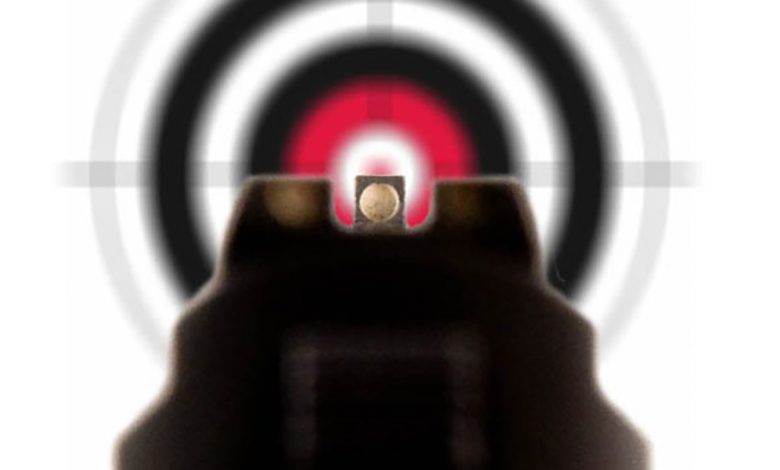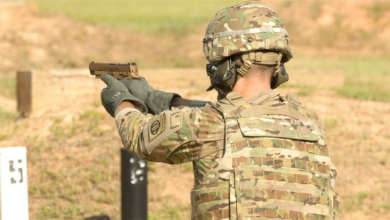Mastering The Crux

Regardless of application, combat or competition, whether rifle or pistol, the ability to rapidly align and maintain a good enough hold to meet the on-target time/accuracy demand is the crux of the shooting process.
Defining the shooting process “bring stability to muzzle-target alignment and press without disturbing that alignment” (codified by grandmaster [GM] and multiple-time world champion Rob Leatham), the goal is to break the round from a stable firing platform. Input of any kind such as change in grip pressure, change in structural support, change in alignment including any unwarranted physical or mental tension, is considered unnecessary input to optimal process execution.
The Crux
A crux refers to the essential or most pivotal point in any situation, idea, or problem. It is the core element upon which everything else hinges. Derived from the Latin word for “cross,” a crux metaphorically represents the crossroads or decision point, where the true significance of an issue becomes clear. In everyday life, we often encounter complex situations, narratives or challenges that seem convoluted, but beneath these layers lies the crux, waiting to be identified.
Understanding the crux of a problem is key to effective problem-solving. It allows us to cut through distractions, focusing on what truly matters. Once it is identified, it provides direction and purpose, enabling one to address the heart of the matter.
The crux of the shooting process is muzzle alignment. It is what takes the most time, the most effort, the greatest skill and the core component that if compromised, shatters the entire shot- placement infrastructure. It is the precise reason why the NRA’s hold control is such a key learning point. Once you have established the hold (stability and alignment) you are set up for success.
You can get away with a bad trigger press and you can even get away with a poor grip—if you maintain alignment. However, the converse is not true: without alignment it doesn’t matter how positive your grip or trigger control is, if the muzzle is out of alignment, you will miss the target to that offset minute of angle.
Delving deeper into the crux of the shooting process, there are three essential subcomponents: kinesthetics, visual guidance and verification.
Kinesthetics
The muzzle is a part of the gun, and the gun is attached to, and considered an extension of, your body, all of which engages the use of human proprioceptors and related kinesthetic resources.
Proprioceptors are specialized sensory receptors found in muscles, tendons and joints. Their main function is to provide the brain with real-time information about the body’s position, movement and force. This sense, called proprioception, allows us to perform everyday actions—like walking, typing, or lifting objects—without needing to constantly look at our limbs. They are the sensory receptors in muscles, tendons and joints that send information to the brain about motion, force and position. Combined, they form a feedback loop that enables coordinated, biomechanical movement and body awareness. Proprioceptors are crucial for athletes, dancers and anyone needing precise motor control, like shooters.
Proprioceptors help us unconsciously navigate the physical world, making them an essential yet often overlooked aspect of human movement and function.
Kinesthetics, or the kinesthetic sense, refers to the awareness of body movements and positioning. It’s the ability to sense and control the movement of muscles and joints, allowing for coordinated physical actions. Kinesthetics relies heavily on proprioceptors, The brain then processes this data to ensure accurate movements without needing to consciously think about each action. It is a subconscious mechanical process.
Kinesthetic awareness is essential in sports, dance and physical training, where precise movements are required. It also plays a critical role in developing motor skills.
As per Leatham, the non-visual process, that is the usage of kinesthetics alone, can account for as much as 75 to 80 percent of the overall alignment process. It is only after that process is completed may your eyes help guide and then verify.
Guiding Eyes
If the technicality of the shot demands sighted fire, then as soon as your sights move into your field of vision, they can be used to either confirm alignment or make micro-adjustments, if needed, toward alignment with the visual center of the intended target.
Once your eyes have completed the guiding process and have verified that you have confirmed alignment, you can then break the shot as you are now past the crux.
The kinesthetic process mechanically aligns, the eyes visually guide and verify. It’s as simple as that—simple yes, but not easy. Significant accuracy and time demand place commensurate burden upon the crux. To get past it is to master the stability-alignment process to a point where it happens subconsciously. Outside the training range you can’t be thinking about the shooting part when your mind should be focused on processing relevant environmental information.
Running drills to kinesthetically and visually develop your stability-alignment efficiencies will help alleviate unnecessary input which will, in turn, significantly contribute to your mastering the crux.
Read the full article here







